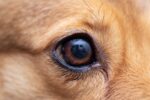 Eye Problems in Dogs: Understanding and Managing Them
Eye Problems in Dogs: Understanding and Managing Them
Eye problems in dogs can result from a variety of causes, including injuries, infections, or underlying health conditions. Identifying the symptoms early and understanding the potential causes can ensure your dog receives timely and effective treatment.
Symptoms of Eye Issues in Dogs
Look out for these common signs of eye issues in dogs:
- Redness or swelling around the eyes
- Discharge or excessive tearing
- Squinting or frequent blinking
- Cloudiness or noticeable changes in eye colour
- Sensitivity to light
- Rubbing or pawing at the eyes
- Vision problems, such as bumping into objects
Common Eye Issues in Dogs and Their Treatments
1. Conjunctivitis
Also known as “pink eye,” this is an inflammation of the conjunctiva, causing redness, discharge, and discomfort. Treatment may involve:
- Antibiotic, antiviral, or anti-inflammatory eye drops, depending on the cause
2. Dry Eye (Keratoconjunctivitis Sicca)
A reduction in tear production can lead to dryness, irritation, and potential corneal damage. Treatment options include:
- Artificial tear solutions
- Medications to stimulate tear production
- Addressing underlying causes
3. Corneal Ulcers
Damage to the cornea can result from trauma, infections, or dry eye. Treatments typically include:
- Antibiotic, antifungal, or pain-relieving eye drops
- Surgery in severe cases
4. Cataracts
Clouding of the lens can impair vision or lead to blindness. Treatment often involves:
- Surgical removal of the cataract, depending on the severity
5. Glaucoma
This condition involves increased pressure within the eye, causing pain, redness, and potential vision loss. Treatment may include:
- Medications to reduce intraocular pressure
- Pain relief
- Surgery in advanced cases
How to Prevent Eye Issues in Dogs
Preventative care plays a vital role in maintaining your dog’s eye health. Here are some tips:
- Regular Veterinary Check-ups: Routine examinations can help detect eye problems before they become severe.
- Proper Grooming: Keep the hair around your dog’s eyes trimmed to reduce irritation and prevent accidental injuries.
- Eye Protection: Use protective eyewear, such as dog goggles, during outdoor activities to shield your dog’s eyes from debris, wind, and UV rays.
- Cleanliness: Regularly clean your dog’s eyes using a soft, damp cloth to remove debris and reduce the risk of infection.
Prioritise Your Dog’s Eye Health
By recognising the symptoms of eye problems and seeking veterinary care promptly, you can protect your dog’s vision and overall well-being. Taking preventative steps, such as regular check-ups and maintaining a clean environment, can further minimise the risk of eye-related issues.

